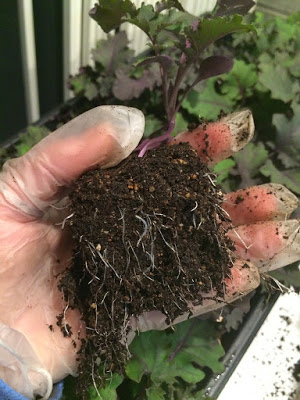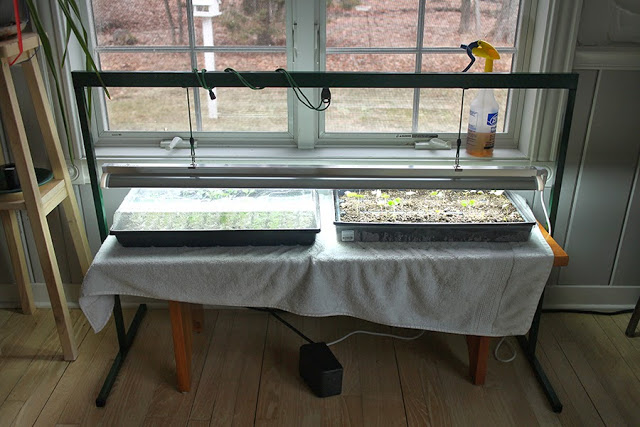In the meantime, I thought I’d run through what I use for my seed starting. There’s nothing super sophisticated about what I use, but I’m pretty happy with the items I have. Really all that’s missing is a proper greenhouse and that’s not exactly something you just randomly order one day.
I’m including links to the places I think I bought these things from or somewhere else I can find them, but it’s worth shopping around to look for a sale. I’ve found many of these items at my local garden center as well.
Some links may be affiliate links, through which I may earn a small commission if you make a purchase. The price you pay doesn’t change. Thank you for shopping through this site!
SEED-STARTING MATS
A heated mat not only helps seeds germinate (most seeds have a temperature at which they germinate best), but it also gives you more options for places you can germinate seeds. Many seeds don’t need light to germinate, so, as long as the soil is warm enough, you can start them anywhere. For me, this means that I can do the germination step in my basement, creating more room in the areas where you have to worry about light. I have a cheap, single-tray heat mat that I don’t recall the source of, and then last year I got a heavyweight double-tray mat that is great. I also got a thermostat for the mat, but it seems like I had it maxed out most of the time last year, so I don’t think that’s really a necessity.
 |
| Soil blocks make it easy to see when seedlings are ready to pot on. |
TRAYS AND MORE
This is something to buy in bulk. You need something to hold the seeds. I like to start just about everything in some kind of module form, rather than planting a big tray and having to prick out seedlings. For some things I’ll use small tray inserts, which are then put in plastic trays (be careful when you buy trays; some have drainage holes in them and some don’t. I prefer ones without holes so I don’t have to worry about water leakage), but last year I grew most things in soil blocks and loved it. You can read about my soil blocking experience here.
If you opt to make your own soil blocks—and I really feel like it’s worth the extra effort—you’ll need a soil blocker. I also like a big tray to mix everything in because there’s a lot of water involved in making soil blocks.
Regardless of which kind of tray you go with, you’ll need a few humidity domes. Don’t skimp these because the thin, floppy ones are completely frustrating. The shallow ones work fine; by the time plants are large enough to outgrow the dome they don’t really need all that humidity anyway. Be careful things don’t get too hot under the domes.
SEED STARTING MIX
You have to have something to grow this stuff in and in most cases, it should be soilless and sterile. Since most of plants I start from seed are edible and since one of the main things I want out of the vegetables I grow is for them to be organic, I choose organic seed mixes. Espoma has a nice one as does Dr. Earth. If you are using soil blocks, you can buy pre-made soil block mixes or make your own, which is my preference. You can find the “recipe” I use here.
 |
| This is my skinny-light setup. Note the spray bottle filled with Manure Tea. |
LIGHTS
Don’t feel like you need to seek out special grow lights. They are essentially souped-up shop lights. That said, I bought special grow lights. 🙂 I have a skinny light with two bulbs in it and a larger one with four-tube lights, which is far superior. The skinny light is the auxiliary light now that I use for plants that are more mature and can survive better with mostly natural light. Don’t skip on the width of your light because you’ll end up having to rotate your trays multiple times a day. Last year I also added an LED light, which I love because of the energy savings. But I don’t feel confident that I had it set up properly so I’ll be playing around with that this year.
I like this stand, which allows you to easily adjust the height of lights. I’m certain you could easily fashion something out of PVC pipes to do the same thing.
My dad bought my mom a stackable growing system for Christmas like this and it looks great. I really like it and had I known my seed-starting habit would grow so much, I probably would have started with something like this.
I also rely on timers to run the lights, leaving them on for about 16-18 hours a day. I don’t use a special timer, just the same ones we use outside for our Christmas lights.
POTTING ON
There comes a time in every seedling’s life when it outgrows its first home. My goal in seed starting is to only have to pot on every plant once before it reaches its final home in the garden, which is why I like the 2-inch soil block size. Seedlings can grow for a fair amount of time before they need to be moved into a real pot (you’ll know when the roots start sticking out the sides). I have oodles of 3-inch and 4-inch plastic pots that I use to pot on seedlings. Most of them are pots I save from buying plants, but if you need to supplement your collection you can buy them.
You can reuse your trays to hold all your pots as well, but I also save flats from nurseries.
WATERING
This is a bit of a no-brainer, but obviously you need to water this stuff. I like to have a spray bottle to mist seedlings if necessary. If I use soil blocks, I water into the bottom of the tray, rather than onto the blocks, which can erode. I also like to use Moo Poo Tea to water with whenever I can. Although I’ve heard some research lately that suggests this doesn’t do much, I don’t think it hurts and it might help.
That’s everything I use for seed starting, save for the seeds, of course. What does you seed starting setup look like?
What would you like to know? Search, or jump to categories below.
7 Responses
Great info! Thanks!
Thanks for the info! I haven't started thinking about seeds this year as I don't normally plant till late February. I have the same grow light stand and love it because it's adjustable – lower when the seedlings are small and higher as they grow to maturity. I'm heading over to the Floret Flower Farm as you've got me thinking about sweet peas.
I'm still starting my seeds in my Solo cups under grow lights. Sweet peas fry in my climate but I already have seedlings for other plants growing! Yay! Happy seed starting. :o)
Hi, just wanted to let you know I can't really read your blog on my iPad. The green you choose on the home page is nearly invisible. Strangely enough it is only on the homepage that it happens.
Kinda frustrating…
[email protected]
Hello there. Just now starting my seeds…I like to start really early to help with the winter blahs. It's great fun, isn't it?
Hi, I am new to gardening/planting/homesteading, so I hope you all can help me out. I love this blog and find everything very interesting. When I read this post I went out and bought little inserts with soil in it already for my seeds to grow in. BUT HELP! What do I do next besides put the seeds in and water each day? What happens when they get bigger? Do I plant them right away in my garden? After the last frost right? I know stupid questions, but I would love to have a garden with my kids this year. Thank you!
Great article for anyone who wants to try growing from seed.